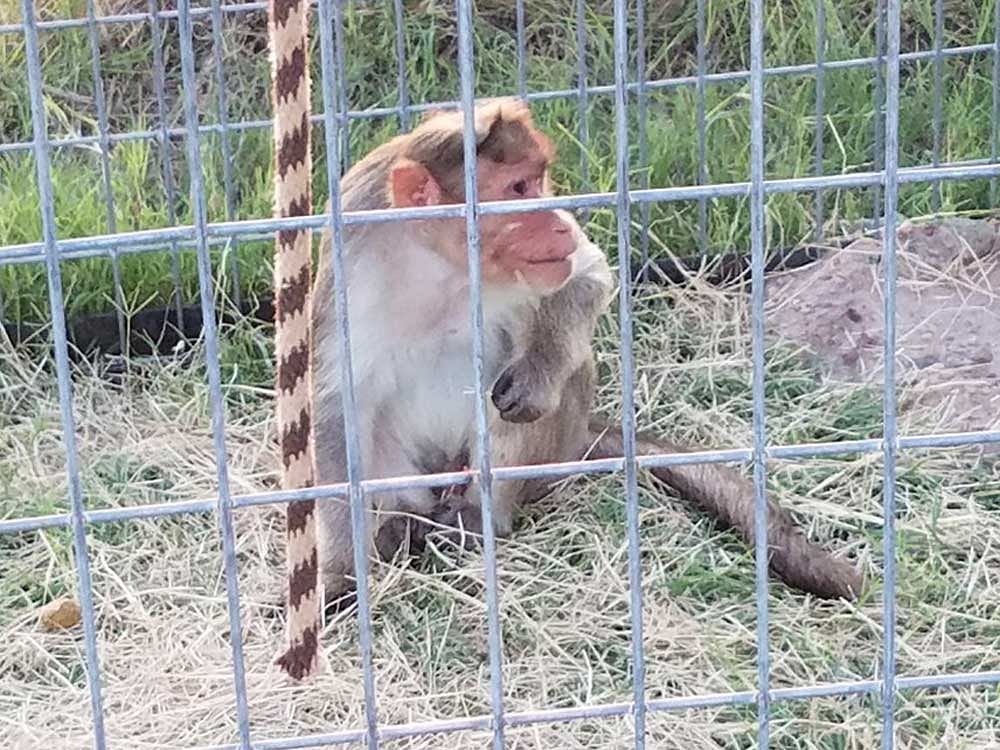Last Updated IST

Bonnet monkeys. Image courtesy Twitter
The population of bonnet monkeys, commonly seen in southern Indian temples and tourist spots for decades, is on a decline.
The number of bonnet macaques (Macaca radiata) monkeys, declined by more than 65% over the past 25 years, and by more than 50% between 2003 and 2015 alone, Indian ecologists have found.
For years, bonnet monkeys were ubiquitous to the landscape south of Godavari and Tapi rivers. But the shortfall in their numbers is now seen in Karnataka, Tamil Nadu, Kerala, Telangana and part of Andhra Pradesh and Maharashtra.
Since these monkeys were also commonplace on the roadside, the researchers studied their presence on seven roads in Mysore. They found monkeys are extinct on the Mysore-Ramnagar road while the numbers reduced by more than 80% in Mysore-HD Kote, Mysore-Hangala and Begur-Handpost roads. The least affected are Chamundi hills and Mysore-Kollegal road.
Overall, nearly 65% of the population of bonnet macaques on these roads has disappeared in the past 25 years. Since the population on Chamundi Hill Road has remained stable, the total decline on all the other roads has been 78%.
“In an area of 100 km from Mysore, trees were cut extensively to expand the roads, which may have wiped out the population. Loss of habitat leads to stress in these animals and affect their reproductive fitness,” Honnavalli N Kumara, lead author of the study from the Salim Ali Centre for Ornithology and Natural History, Coimbatore told DH.
On one hand, the number of bonnet macaques declines in temples and tourist spots where they receive food from humans, while the population dwindled on the roadside because of loss of canopy cover. Their numbers are not many in the forests as it is not a forest dwelling species.
Kumara and his colleagues from the University of Mysore, Bharathiar University, Coimbatore, Jawaharlal Nehru Centre for Advanced Scientific Research, Bangalore and Bar-Ilan University Israel studied these monkeys that are considered to be of the least concern for conservation. Other areas they studied are several reserved forests in Karnataka and Tamil Nadu.
In the past, common species like House sparrow (Passer domesticus); Starling (Sturnus vulgaris) and Long-tailed macaque (Macaca fascicular) witnessed a sharp decline in their populations in several countries over the last few decades.
“Another contributing factor is an invasion of Rhesus macaque, which was earlier seen in north India but are now being spotted in Andhra Pradesh and Maharashtra. Being more aggressive, the Rhesus is taking over the habitats,” Kumara said.
The number of bonnet macaques (Macaca radiata) monkeys, declined by more than 65% over the past 25 years, and by more than 50% between 2003 and 2015 alone, Indian ecologists have found.
For years, bonnet monkeys were ubiquitous to the landscape south of Godavari and Tapi rivers. But the shortfall in their numbers is now seen in Karnataka, Tamil Nadu, Kerala, Telangana and part of Andhra Pradesh and Maharashtra.
Since these monkeys were also commonplace on the roadside, the researchers studied their presence on seven roads in Mysore. They found monkeys are extinct on the Mysore-Ramnagar road while the numbers reduced by more than 80% in Mysore-HD Kote, Mysore-Hangala and Begur-Handpost roads. The least affected are Chamundi hills and Mysore-Kollegal road.
Overall, nearly 65% of the population of bonnet macaques on these roads has disappeared in the past 25 years. Since the population on Chamundi Hill Road has remained stable, the total decline on all the other roads has been 78%.
“In an area of 100 km from Mysore, trees were cut extensively to expand the roads, which may have wiped out the population. Loss of habitat leads to stress in these animals and affect their reproductive fitness,” Honnavalli N Kumara, lead author of the study from the Salim Ali Centre for Ornithology and Natural History, Coimbatore told DH.
On one hand, the number of bonnet macaques declines in temples and tourist spots where they receive food from humans, while the population dwindled on the roadside because of loss of canopy cover. Their numbers are not many in the forests as it is not a forest dwelling species.
Kumara and his colleagues from the University of Mysore, Bharathiar University, Coimbatore, Jawaharlal Nehru Centre for Advanced Scientific Research, Bangalore and Bar-Ilan University Israel studied these monkeys that are considered to be of the least concern for conservation. Other areas they studied are several reserved forests in Karnataka and Tamil Nadu.
In the past, common species like House sparrow (Passer domesticus); Starling (Sturnus vulgaris) and Long-tailed macaque (Macaca fascicular) witnessed a sharp decline in their populations in several countries over the last few decades.
“Another contributing factor is an invasion of Rhesus macaque, which was earlier seen in north India but are now being spotted in Andhra Pradesh and Maharashtra. Being more aggressive, the Rhesus is taking over the habitats,” Kumara said.
Deccan Herald is on WhatsApp Channels| Join now for Breaking News & Editor's Picks
